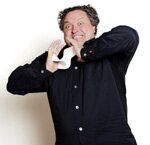 |
| Bruce Mau's vision of the future might be too perfect. |
"You are too perfect."
The words come from Bruce Mau, one of the world’s most important and radical designer, and who during conversation, completely without affectation, can begin a sentence with "Me and Frank," referring to the architect that designed, among others, Seattle’s Experience Music Project, Los Angeles’ Disney Concert Hall, and the Guggenheim museum in Bilbao, Spain: Frank Gehry.
Not many people can do that. Then again, not many people can say they have created a vision for the future of an entire country that includes an energy bill of zero without having to reduce consumption or worry about the depletion of oil and gas reserves. Bruce Mau Designs, by coordinating and collaborating on the exhibition “Too Perfect: Seven New Denmarks,? has realized the future. Here is an excerpt of his view:
"The Danish Architecture Centre (DAC) had a hunch that in order to cut a clearing in the forest for reinvention and to return Danish design to a leading position on the international scene, it was necessary to look at Danish culture and tradition with new eyes. DAC called in Canadian design studio, Bruce Mau Design, to work with a team of Danish architects.
"Bruce Mau Design believes that design has become a way of thinking that is relevant to all aspects of living. Design allows us to re-imagine the way we live. It reveals opportunities. For design to do that, we must liberate ourselves from the straitjacket of style, and figure out what we want as effects, as capacity – the human capacity to plan and produce desired outcomes. We would like to propose a new model of design that encompasses life in all its complexity and imperfection; a model that provides a way of responding to basic questions of human existence – How should we live? Who might we become?"
To answer that, we formed a collaboration with five teams of extraordinarily talented young Danish architects and designers: PLOT, Arkitema, Kontrapunkt, NORD and SRL Arkitekter. Together we have travelled from Denmark's farmlands and coastline to its cities and ports, and we have developed seven propositions that push us to the edge of our social imagination. Each one starts with our current condition, and imagines a set of design solutions. Then it claims and explores the territory in between here and there, finding in that middle ground "pragmatic utopias." A pragmatic utopia rests on a triple bottom line of economic, social, and ecological sustainability. It uses argument and analysis to develop its proposition. It takes architecture beyond the realm of buildings and into other areas of life that we have the capacity to design. It has universal potential. If Denmark were to adopt any one of these pragmatic utopias, there would be a global resonant impact.
 |
| PLOT, as you can see it in Venice. |
Perhaps the most compelling of these “pragmatic utopias,? as he calls them, is the model submitted by Danish architect studio PLOT. They have re-imagined the world, and re-thought the Danish energy system. What did they come up with? In the future, there will be no energy bills in Denmark.
"What we need is an energy currency into which all energy can be invested. That currency is hydrogen. Hydrogen can be created from all known sources of renewable energy, and can be transformed back to electricity and heat, almost without loss," says Bjarke Ingels, co-founder and partner of PLOT architects. "If all kinds of waste are transformed into hydrogen, even the smallest waste products can be exchanged and used by others. Hydrogen can become central players in this new decentralized peer-to-peer energy society, acting at the same time as consumers, carriers, and producers of energy."
Imagine, a completely self-contained, self-powered, self-regulating community where you can park your car, go about your daily business, including a visit to the library or oxygen bar, and then refuel your vehicle before heading home without producing any waste, harmful emissions, or greenhouse gasses. This vision is real, according to the exhibition, and here’s how it works:
There are six buildings in each block. Each block has a large parking garage or area which doubles as a fueling station for all the cars in the entire block. The buildings are shaped in optimized angles for maximum solar exposure and power production. Vegetation grown on southern facades allows for heat gain in the winter, and sun shading in the summer. Rainwater collected from the facades will cover 100% of the water needs, as it is suitable for all water needs, aside from drinking. Exhaust from the hydrogen-powered cars is steam, and helps to regenerate the clouds, which produce more rain. The hydrogen plant located in the middle of each building produces, along with hydrogen, only two byproducts: oxygen and heat. This excess oxygen feeds the oxygen bar at the peak of the pyramid, and the heat can be used to warm water for showers and other needs. It’s a near-perfect system.
What looks like utopia on a large scale has been realized in this miniature model. The exhibition is on view simultaneously in Copenhagen, Toronto and Venice. You can take a peek at the future of hydrogen-powered society in any of these cities until March 2005.
|

